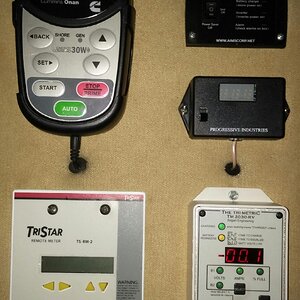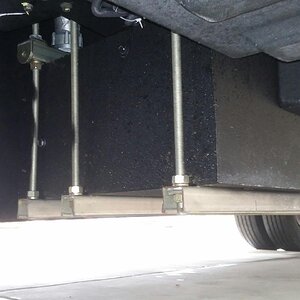Neal
Administrator
- Joined
- Jul 27, 2019
- Messages
- 13,872
- Location
- Midlothian, VA
- RV Year
- 2017
- RV Make
- Newmar
- RV Model
- Ventana 4037
- RV Length
- 40' 10"
- Chassis
- Freightliner XCR
- Engine
- Cummins 400 HP
- TOW/TOAD
- 2017 Chevy Colorado
- Fulltimer
- No
My inner tire on the dual tire axle has a rubber grommet that holds the tire inflation valve extension in place. This grommet has been a battle to stay in place since day 1. I think the reason is the TST Tire pressure flow through valve and it's weight. Yesterday I left the CG and I had recently adjusted tire pressures due to changing temps and elevation in my travels from AZ to VA. I did not get a sensor reading on my left inner tire so I figured the battery needed to be replaced and as I had just adjusted pressures I was sure all was well. Famous last words right??? 1 mile prior to exiting for a Love's fuel stop my TST alarm goes off and shows 1 psi. Well...at least the sensor picked up but is this legit? I thought it was a false reading but I slowed down for the last mile and exited for Love's and sure enough, inner tire was flat, 0 psi!
Visual inspection although limited didn't reveal anything so I aired up thankfully with Love's air hose at the pump. My hunch was what had happened to me before as I had a slow leak on an inner tire in the past and @Chuggs offered it was likely the valve extension. Back then I torqued it slightly tighter and the problem went away. So I grabbed my pliers and after airing up I torqued it tight. The valve extension has taken a beating on the rim thanks to the TST sensor and I've been wondering when it's going to fail but I don't think it's failed yet. I have a FL service coming up and I plan to have them inspect it and change it if needed. I'm ready to leave Love's and now the question is whether or not to put the TST sensor on again. If I don't then I'll have to stop and make frequent tire pressure checks, if I install it then what will happen. I reseated the grommet that was no longer in place. The other option was to stay at Love's and see if they have a tire service person available (it's Sunday) or call Coach-net. I decided to install the sensor and hit the road, 1 hour lost so far for this. The tire pressure held fine for the 5 hours of driving.
Upon arrival at the CG site I went back to check the tire and I could hear air coming out, I'm not sure if it was the sensor itself, my hunch is that it may be compromised. I took the sensor off and no air leak noises. I checked pressure this morning and it was down 10 psi from when I arrived but it's also significantly cooler and we know while driving we're typically around +10 psi. I think it's holding.
So now I have to decide my plan going forward, to use a tire pressure sensor on the inner dually or not? I don't think the weight of the sensor is playing well with the grommet and also causing the valve extension to wear down on the wheel itself. It's a lose lose situation and I trust the tires and my concern is least about the inner dually's.
What's your experience and opinion on the above? Tire grommet issues? Sensors on the inner dually?
Visual inspection although limited didn't reveal anything so I aired up thankfully with Love's air hose at the pump. My hunch was what had happened to me before as I had a slow leak on an inner tire in the past and @Chuggs offered it was likely the valve extension. Back then I torqued it slightly tighter and the problem went away. So I grabbed my pliers and after airing up I torqued it tight. The valve extension has taken a beating on the rim thanks to the TST sensor and I've been wondering when it's going to fail but I don't think it's failed yet. I have a FL service coming up and I plan to have them inspect it and change it if needed. I'm ready to leave Love's and now the question is whether or not to put the TST sensor on again. If I don't then I'll have to stop and make frequent tire pressure checks, if I install it then what will happen. I reseated the grommet that was no longer in place. The other option was to stay at Love's and see if they have a tire service person available (it's Sunday) or call Coach-net. I decided to install the sensor and hit the road, 1 hour lost so far for this. The tire pressure held fine for the 5 hours of driving.
Upon arrival at the CG site I went back to check the tire and I could hear air coming out, I'm not sure if it was the sensor itself, my hunch is that it may be compromised. I took the sensor off and no air leak noises. I checked pressure this morning and it was down 10 psi from when I arrived but it's also significantly cooler and we know while driving we're typically around +10 psi. I think it's holding.
So now I have to decide my plan going forward, to use a tire pressure sensor on the inner dually or not? I don't think the weight of the sensor is playing well with the grommet and also causing the valve extension to wear down on the wheel itself. It's a lose lose situation and I trust the tires and my concern is least about the inner dually's.
What's your experience and opinion on the above? Tire grommet issues? Sensors on the inner dually?












